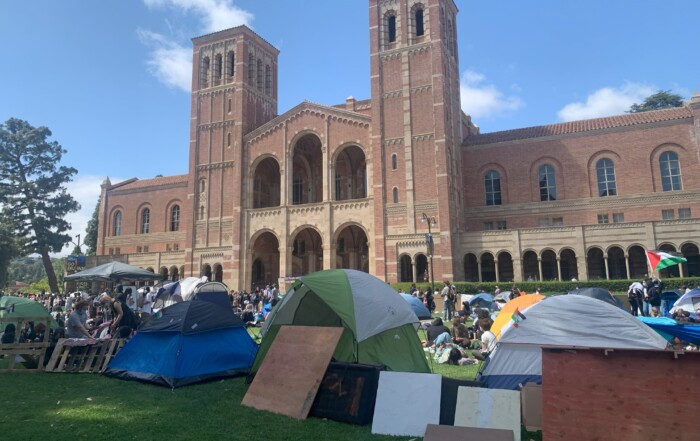Candidates seeking office aren’t the only people busier than ever as the Primary Election rolls closer.
In preparation for Measure HLA’s possible passage on March 5, the Los Angeles City Council’s Transportation Committee held discussions Wednesday with the City Administrative Office, the Planning Department, and the City Attorney’s office on several key factors for implementing the city’s Mobility Plan 2035 — an element of the General Plan initiated in 2016 to create a better environment for all forms of transportation in Los Angeles — with a focus on the Bicycle Enhanced Network, Bicycle Lane Network, and sidewalks in the Pedestrian Enhanced District.
Why? Concerns were raised about the measure that could leave the city open to lawsuits should it pass, as Measure HLA would require faster implementation of the Mobility Plan. If the city fails to comply, it opens an avenue for legal liability, and city officials did not give a clear answer as to their ability to meet the potential requirements.
“I don’t want to say yes in a room full of plaintiffs,” Assistant City Attorney Ed Jordan said jokingly in response to a question about the city’s ability to meet the requirements of Measure HLA.
The Bicycle Enhanced Network and Bicycle Lane Network each focus on distributing about 660 miles of bikeways in various forms throughout the City of Los Angeles, of which 285 miles have already been implemented. The projections for the total cost of implementing these networks range from $1 billion to over $3.25 billion.
Many of the paths in the 260 miles of the Bicycle Enhanced Network will be Class IV bikeways — defined by the California Department of Transportation as a bikeway for the exclusive use of bicycles that includes a separation from any through traffic — and Class I bikeways that are separated from the roads entirely like the Ballona Creek Bike Path in Culver City will also be included.
More traditional on-street bike paths — defined by CalTrans as Class II — will be implemented throughout the city by the Bicycle Lane Network. There will be anywhere from 470 to 660 miles of bike lanes comprising this network, but the length is dependent on sidewalk and street conditions.
These conditions were one of several logistical topics that the city’s Transportation Committee looked to gain clarity on during this meeting. According to the Planning Department’s representative at the meeting, a corridor must have a Pavement Condition Index (PCI) of at least 80 for the city to be able to build bikeways in it.
The PCI gives roads a score from 0 to 100 based on the damage or alterations on the pavement in the corridor and is calculated by subtracting points based on the type of damage from the 100 score given to a newly paved road. Staff noted that the coordination required to align PCI with the Mobility Plan is one of several barriers that have resulted in a very slow rollout of the Mobility Plan by most standards.
This slow progress of implementing projects from the Mobility Plan was also a concern, as just 8 percent of the bicycle-enhanced network had been installed since the plan’s inception in 2016. According to city staff, this is in part because the Mobility Plan is a blueprint that isn’t designed to be implemented quickly and does not include things like specifics of engineering and feedback from community input, which are gathered for individual projects and not larger plans.
“We can set the vision, but we cannot define the actual on-the-ground dimensions and parameters that really do need to be fleshed out by other departments,” city planner Steven Katigbak said at the meeting.
Concerned about this lack of progress, transportation advocates began collecting signatures to put Measure HLA on the ballot in early 2022, an undertaking which succeeded when the ballot measure was certified that summer for the March 2024 election. That same June, the city council moved for city staff to draft a Mobility Plan Implementation Ordinance that would guide an approach toward the implementation of the plan.
The eight-page draft ordinance dated August 7, 2023, primarily requires that work on a corridor listed as part of the Mobility Plan must also include projects designated by the plan for that corridor. It also provides guidelines on the chain of command for the implementation of Mobility Plan projects and an appeal process for residents who believe projects are not compliant with the Mobility Plan.
City staff explained that many of the aspects of the ordinance were included because the city council directed staff to ensure those things were covered in the ordinance.
“Much of what’s there is there because it was in the council’s request,” Jordan explained.
Committee member and Fourth District Councilmember Nithya Raman also read several amendments into the ordinance, explaining that they come from the correspondence from the Bureau of Engineering, the Department of Transportation, and the Department of City Planning. These amendments help clarify parts of the appeal process and the specific roles of city departments in projects.
Eleventh District Councilmember Traci Park noted the similarities between the ordinance and Measure HLA, but wanted staff to highlight significant differences between them. The main difference that city staff raised was the fact that Measure HLA does not take community feedback into account when determining whether or not a project should be built.
Park also asked about what would happen if both the ordinance and the ballot measure are passed, and staff confirmed that the ballot initiative would take precedence. However, anything in the city ordinance that is not inconsistent with the ballot measure would still be allowed to go into effect.
Finally, the question of whether or not the city has the resources was brought up by Park. Staff noted the gravity of the cost for full implementation of these networks — which greatly dwarfed the budgets of several departments and initiatives, including the $1.3 billion designated to combat homelessness in the 23-24 fiscal year budget.
“For Vision Zero our budget is $33 million, and for Active Transportation our budget is $10 million,” general manager of the Los Angeles Department of Transportation Laura Rubio-Cornejo said. “Even with that budgeted amount, resources are at capacity.”
Jordan noted that the ordinance being passed could mean having fewer projects happen overall, as Measure HLA is triggered by work on city-owned right-of-way.
Following about an hour of discussion, the members of the committee felt as if there wasn’t enough discussion around the ordinance, and it would be continued at the committee’s next meeting expected to occur on January 31. First District Councilmember Eunisses Hernandez requested that StreetsLA, a division of Public Works that would be very involved in implementation, be present at this meeting.
Photo by JohnnyH5 on iStockphoto.com
Stay informed. Sign up for The Westside Voice Newsletter
By clicking submit, you agree to share your email address with Westside Voice. We do not sell or share your information with anyone.








